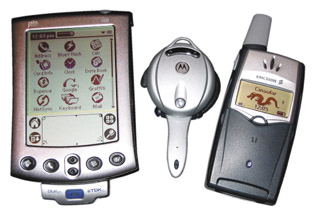|
|
 Palm ColumnWireless data: Something for everyone by Shawn Barnett by Shawn BarnettApril 2002, issue 44
Three major methods are emerging for enabling wireless data on Palm OS devices, two of which are reviewed in this issue. Depending on many factors, this divergence could inject either confusion or convenience into the market. Software developers have the main burden to keep it simple and keep the market open, despite the temptation to specialize on one method or other. The newly-named PalmSource Inc., formerly the Palm OS Subsidiary, has the task of keeping the convenience of the Palm OS intact, regardless of how we choose to expand the capability of our devices, and this includes encouraging developers to their software compatible with these three wireless transmission methods.
There will actually be even more choices for wireless, but the three major wireless models I'll explore are the "all-in-one" device, exemplified by the Handspring Treo; the data-only device, like a Palm i705 or Palm/wireless sled combination, with the addition of a cell phone for voice; and a two-to-four-piece solution using a Palm, a cell phone, and an optional wireless earbud, all held together by a PAN (Personal Area Network) like Bluetooth. Each option is easy in a few ways, and clumsy in a few others.
The all-in-one device has a clear advantage right up front. With three functions covered, pager, phone, and PDA, you need bring only one thing along to have not only your contacts, but the ability to reach those contacts via voice or text. The larger screen allows Web browsing and email management as well, plus devices like the Treo can run most software applications like any other Palm.
Dialing from the address book eliminates the odd human interaction of having to use eyes and fingers to re-enter data that is already in digital form in one electronic device, as we currently do with PDA and cell phone combinations. With the Kyocera, Samsung, VisorPhone, and Treo, you just find the number in the Address Book and tap to dial it. The Treo further refines the process by allowing just a few characters to be entered for name lookup (see Treo review on page 52).
There's also the greater simplicity of only needing at most two chargers on a trip: a car charger and wall charger. Add a headset and you add yet another item and a cord, but this is optional with the Treo, since it has a speakerphone mode.
Disadvantages to the all-in-one model become more apparent when more than one person wants you at once. The Treo does allow better use of commonly available services like call waiting and conference calling, but as soon as an SMS or an email notification come in at the same time, you can start to see a limitation. It's not even a limitation of the device, but of the human trying to successfully interact with a two and three quarter inch screen. Handspring has done a great job making all this work together, but do one thing wrong and it can take some careful navigation to get back to the screen you need.
And if you're browsing on a packet-switched connection, you can't receive a call at all. I've missed some urgent calls using other phones with this limitation, something that wouldn't have happened if I were browsing with a data-only device. Because urgent communication is more likely to come via voice call, I have thus far stayed with the next category for my mobile solution.
The introduction of the Palm i705 with its full PDA, wireless data radio, and pager-like email notification allows this category to compete handily with the Treo. You get wireless data on the well-distributed Mobitex network and you can choose whatever cell phone provider is stronger or cheaper in your area, plus the cell phone form factor you prefer, be it flip, small, large, or even a Nextel with the cool iDEN radio. Likewise, if CDPD is stronger in your area, you can use whatever Palm OS device you want with a CDPD modem attached instead of an i705.
This option offers more than just choice. You can browse the web or send and receive an email while on a call, or still receive a call while doing either. As for accessing data already on the PDA while talking, you can also do that on the Treo, so there's no advantage there.
The i705 will automatically enter an email address from the Address Book after only a few characters, but it can't by itself dial a phone number from the Address Book. Also on the disadvantage list is the burden of two devices. Most Palm OS users are already doing this, so it's at least nothing new.
What may become the more versatile of the three options is the vision expressed over a year ago at PalmSource 2000, and now coming to a store near you: a Personal Area Network, with your Palm device connected to your cell phone via Bluetooth. Select a number on the Palm and tap it to dial. The Palm transmits the number to the cell phone and the call is placed. The Palm can also use this method to dial out on data calls. Add a Bluetooth earbud and you can just bury the cell phone in a jacket or leave it on your belt as the wireless access point. Answer calls with the earbud and place them with the Palm.
The photograph above illustrates the choices possible with this concept. The customer is given the option to choose his favorite brands with the specific features he needs, and no longer has to worry whether a given company makes a cable compatible with both devices. If one component in the PAN fails, it alone can be easily replaced.
Of course, the cell phone network is again the limitation, since using data services disables the most important function: the voice call. Furthermore, while Bluetooth does a handy job of eliminating wires for device connection, at some point you're going to need to recharge all these wonders, meaning at least three, if not six charging cables, for car and wall, might be necessary.
A more robust solution could be created by bringing the i705 into the picture with a Palm SD Bluetooth card, now available in stores, or the TDK sled. You'd get dialing from the Palm's Address Book, data, Web, email, paging, uninterrupted voice, and the option of using one or other device for at least some form of communication in fringe areas. This will likely be my choice, since I live in a hilly area. All I need is my carrier to come out with a Bluetooth phone. Of course, the Treo offers nearly all these things in one device for a far lower price than the above items combined, plus a single subscription plan.
Whichever you decide is for you, the good news is that we finally have something we've needed for awhile: Choice.
|
|||
|
[Homepage] All contents ©1995-2000 Pen Computing Magazine, Inc. All rights reserved. |
||||


